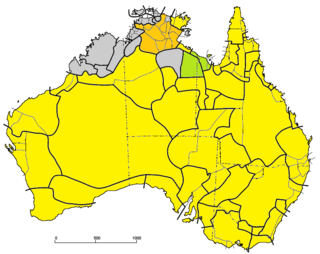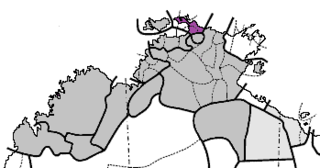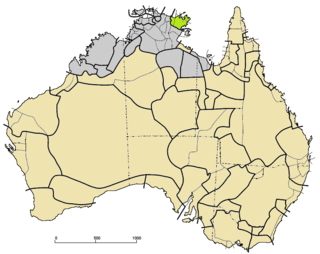
The Indigenous languages of Australia number in the hundreds, the precise number being quite uncertain, although there is a range of estimates from a minimum of around 250 up to possibly 363. The Indigenous languages of Australia comprise numerous language families and isolates, perhaps as many as 13, spoken by the Indigenous peoples of mainland Australia and a few nearby islands. The relationships between the language families are not clear at present although there are proposals to link some into larger groupings. Despite this uncertainty, the Indigenous Australian languages are collectively covered by the technical term "Australian languages", or the "Australian family".

Gaagudju is an extinct Australian Aboriginal language formerly spoken in the environs of Kakadu National Park, in Arnhem Land, Northern Territory, Australia.
Mingginda or Minkin is an extinct Australian Aboriginal language, perhaps a language isolate, of northern Australia. It was spoken by the Mingin people in the area around Burketown, on the southern coast of the Gulf of Carpentaria, in an area that contains the headwaters of the Leichhardt River.

The Tangkic languages form a small language family of Australian Aboriginal languages spoken in northern Australia.

Maningrida, also known as Burarran, is a small family of Australian Aboriginal languages spoken in northern Australia. It includes four languages, none closely related:

The Iwaidjan or Yiwaidjan languages are a small family of non-Pama–Nyungan Australian Aboriginal languages spoken in the Cobourg Peninsula region of Western Arnhem Land.
Bininj Kunwok is an Australian Aboriginal language which includes six dialects: Kunwinjku, Kuninjku, Kundjeyhmi, Manyallaluk Mayali (Mayali), Kundedjnjenghmi, and two varieties of Kune. Kunwinjku is the dominant dialect, and also sometimes used to refer to the group. The spellings Bininj Gun-wok and Bininj Kun-Wok have also been used in the past, however Bininj Kunwok is the current standard orthography.

The Wunambal language, also known as Northern Worrorran, Gambera or Gaambera, is a moribund Australian Aboriginal language of Western Australia. It has several dialects, including Yiiji, Gunin, Miwa, and Wilawila. It is spoken by the Wunambal people.

Yolŋu Matha, meaning the 'Yolŋu tongue', is a linguistic family that includes the languages of the Yolngu, the indigenous people of northeast Arnhem Land in northern Australia. The ŋ in Yolŋu is pronounced as the ng in singing.
Gurr-goni, also spelled Guragone, Gorogone, Gun-Guragone, Gunagoragone, Gungorogone, Gurrogone, Gutjertabia, is an Australian Aboriginal language spoken in Arnhem Land. There were about 60 speakers in 2011, all trilingual in Burarra or Kuninjku.
The Ndjébbana language, also spelt Djeebbana and Ndjebanna and also known as Kunibidji, is a Burarran language spoken by the Gunavidji (Ndjebbana) people of North-central Arnhem Land in the Northern Territory of Australia.
The Burarra language is an Australian Aboriginal language spoken by the Burarra people of Arnhem Land. It has several dialects.
Boiken is one of the more populous of the Ndu languages of Sepik River region of northern Papua New Guinea. It is spoken around Boiken Creek in Yangoru-Saussia District, East Sepik Province and adjacent islands off the north coast of northern Papua New Guinea.
The Maringarr language is a moribund Australian Aboriginal language spoken along the northwest coast of the Northern Territory.

Worrorra, also written Worora and other variants, and also known as Western Worrorran, is a moribund Australian Aboriginal language of northern Western Australia. It encompasses a number of dialects, which are spoken by a group of people known as the Worrorra people.
Alawa (Galawa) is a moribund Indigenous Australian language spoken by the Alawa people of the Northern Territory. In 1991, there were reportedly 18 remaining speakers and 4 semi-speakers.
Djinang is an Australian Aboriginal language, one of the family of Yolŋu languages which are spoken in the north-east Arnhem Land region of the Northern Territory.

The Macro-Gunwinyguan languages, also called Arnhem or Gunwinyguan, are a family of Australian Aboriginal languages spoken across eastern Arnhem Land in northern Australia. Their relationship has been demonstrated through shared morphology in their verbal inflections.
The Marrku–Wurrugu languages are a possible language family of Australian Aboriginal languages spoken in the Cobourg Peninsula region of Western Arnhem Land. They are the recently extinct Marrgu, and the extinct Wurrugu. They were once classified as distant relatives of the other Iwaidjan languages, until Nicholas Evans found the evidence for Marrgu's membership insufficient, concluding that similarities were due to borrowing.
The Bininj are an Aboriginal Australian people of Western Arnhem land in the Northern Territory. The sub-groups of Bininj are sometimes referred to by the various language dialects spoken in the region, that is, the group of dialects known as Bininj Kunwok; so the people may be named the Kunwinjku, Kuninjku, Kundjeyhmi (Gundjeihmi), Manyallaluk Mayali, Kundedjnjenghmi and Kune groups.








